Wind turbine energy production is a growing field of electricity generation; in 2020, the total wind power capacity in the world is 743GW. As the wind plants are producing less pollution, the demand for wind power generation is growing.
The efficiency of a wind turbine depends on many factors, like the type of turbine, the blade geometry, available wind velocity etc. 59% is the maximum efficiency that can be achieved by a wind turbine. The practical efficiency of a wind turbine varies between 30 -45%, and it may rise to 50% during peak wind.
If the turbine is working at 100% efficiency, the wind speed after striking the turbine becomes zero, which is impossible.
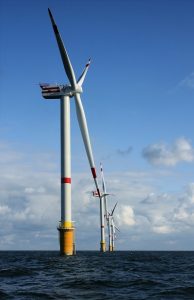
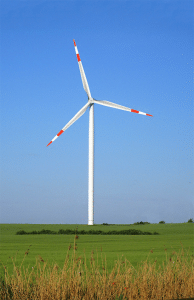
Wind turbine efficiency formula
The calculation of efficiency is essential; the efficiency helps to compare the performance of different wind turbines and optimum wind speed for maximum efficiency.
Co-efficient of power is the more common word for efficiency of the wind turbine. The Cp is defined as,
The amount of electricity produced by a wind turbine can be calculated from the generator output. The below equation calculates the input kinetic energy,
Where,
A is the covered area of the wind turbine, V is the wind speed, ρ is the air density.
The Cp value varies with respect to the wind speed; hence the efficiency of the wind turbine varies while operating.
Further, the Cp depends on turbine parts, i.e. the turbine blades, shafts and generator. Therefore, the multiplication of aerodynamic efficiency of blades, mechanical efficiency of the shaft and electrical efficiency of generator provide the value of Cp.
Maximum efficiency of wind turbine
The maximum possible efficiency of the wind turbine is proposed by Albert Betz, a German physicist, in 1919. It provides insight into the maximum possible turbine efficiency.
The Betz’s limit shows that 59.3% is the maximum possible efficiency of a wind turbine. Hence, the turbine efficiency never exceeds 59%, including all other losses it comes to 35-45% value in practical cases.
Let’s assume that the efficiency of a wind turbine is 100% that means the turbine consumes all the air energy. If it happens, the velocity of air after passing the turbine becomes zero. That means the air is not flowing, which hinders the further flow of air. Thus, this is an impossible situation.
Now, if the inlet and exit air velocity are the same, that means no energy is extracted, which gives 0% efficiency to the turbine. Hence the maximum possible turbine efficiency is somewhere between 0 and 100%, excluding these limits.
Betz proved that the maximum possible efficiency is 59.3% for a wind turbine with maths and solid physics.
Types of wind turbines and their efficiencies
A variety of wind turbines are available according to the axis of rotation and design of blades. The most commonly used wind turbine is the Horizontal axis wind turbine. However, other kinds of turbines are also used for appropriate conditions. The different types of turbines are,
Let’s discuss the efficiency of these turbines separately,
Horizontal axis wind turbine (HAWT) efficiency
The horizontal axis wind turbines are commonly used for large plants, where enough space and wind is available. The axis of rotation of the turbine blade is parallel to the earth surface.
The efficiency of HAWT varies between 35-50%. Currently, HAWT has the highest efficiency.
The captured wind energy by wind turbine depends on the area covered by the turbine blades. For a HAWT, the area is calculated as follows,
A = πL2
Where, L is the length of blade. The length varies between 20 to 80 meters.
Usually these wind turbines are used for large production plants. Most common horizontal wind turbine is 3 bladed, and the colour of turbines usually white for visibility by aircraft.
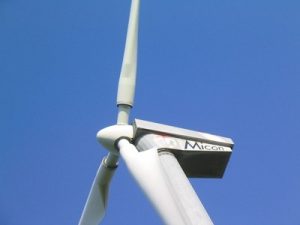
Vertical axis wind turbine (VAWT) efficiency
The vertical axis wind turbines are commonly used for small energy production where the space is constrained. The axis of rotation of blades of vertical axis wind turbines is perpendicular to the Earth surface.
The efficiency of VAWT is less compared to HAWT.
As discussed, the efficiency depends on the area of turbine blades exposed to wind. For VAWT, the area exposed is,
A = DH
Where D and H are the diameter and height of the blades.
Different kinds of VAWT are available. Darrius wind turbine and Savonius wind turbine are common VAWT. The efficiencies of these two are discussed below.
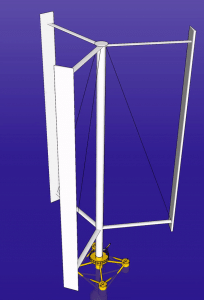
Darrius wind turbine efficiency
Darrius wind turbine is a VAWT.
The efficiency of the Darrius wind turbine is between 30-40%. The usage of these turbines are limited even though these are having high efficiency mainly due to inability to self-start.
Darrius turbine is a lift based turbine. The figure shows a Darrius wind turbine. As shown below, a number of aerofoil blades are mounted on a vertical shaft that rotates. The blades are stressed only in tension for these turbines due to the curvature. The design is developed by French engineer Georges Jean Marie Darrieus. These are commonly used near to human habitat, on the top of a building or in the centre of a road. However, the protection of the turbine is tough in extreme conditions.
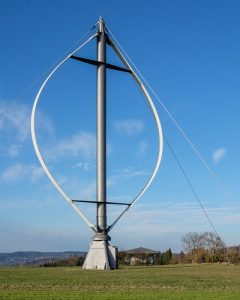
Savonius wind turbine efficiency
Savonius wind turbine is a different type of VAWT. Unfortunately, the efficiency of these turbines is very low.
The efficiency of the Savonius wind turbine varies between 10-17%. Even though the efficiency is very low, due to the simple structure and reliability of the turbine, these are used to produce a small amount of electricity in appropriate locations.
Savonius turbine is drag based turbine. The figure shows an actual Savonius wind turbine. The top view of the blade is also shown in the below figure.
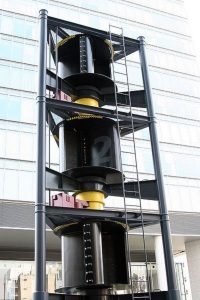
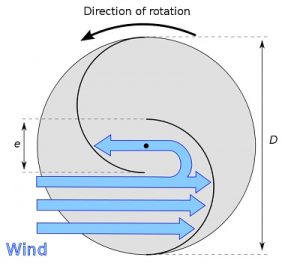
Finnish engineer Sigurd Johannes Savonius developed the Savonius wind in 1922. There are two types of blade design for Savonius wind turbine, barrel design and ice wind design. The top view barrel wind turbine is shown above. The blades are half-cylindrical; the barrels are not meeting in the centre; they are away from the centre, which enables the free motion of wind in the blade.
Bladeless wind turbine efficiency
The bladeless wind turbines are a particular type of wind turbine, these turbines don’t have revolving blades, and the turbine works based on vortex-induced vibration.
The efficiency of a bladeless wind turbine is very less compared to any other wind turbine. However, lightweight, cost-effectiveness and less maintenance are the advantages of the bladeless wind turbine. In addition, the turbine requires less space; hence, more turbines can be installed than the usual wind turbine.
Archimedes wind turbine efficiency
Archimedes wind turbine is a recently developed technology. These are small structures and can be used on rooftops, on roads, etc.
Compared to conventional wind turbines Archimedes wind turbines are more efficient. In addition, the turbine reduces many other problems related to conventional turbines.
For example, the noise produced by Archimedes wind turbines is significantly less compared to the conventional turbine. The shape of the turbine is modelled similar to the spiral of a Nautilus shell. This shape enables the turbine to self-adjust the turbine face according to the wind flow.
Factors affecting wind turbine efficiency
The efficiency of wind turbines are already discussed above, from that the factors affecting turbine efficiency are,
- The wind speed.
- The air density.
- Blade radius.
- Type of wind turbine
Wind turbine efficiency comparison
Let’s conclude the wind turbine efficiency here. The wind turbine efficiency is tabulated below.
| Turbine | Efficiency |
| Horizontal axis wind turbine | 30-45 |
| Vertical axis wind turbine | 10-40 |
| Darrius wind turbine | 30-40 |
| Savonius wind turbine | 10-17 |
| bladeless wind turbines | Very less |
For more posts on Mechanical Engineering, please follow our Mechanical page

The lambdageeksScience Core SME Team is a group of experienced subject matter experts from diverse scientific and technical fields including Physics, Chemistry, Technology,Electronics & Electrical Engineering, Automotive, Mechanical Engineering. Our team collaborates to create high-quality, well-researched articles on a wide range of science and technology topics for the lambdageeks.com website.
All Our Senior SME are having more than 7 Years of experience in the respective fields . They are either Working Industry Professionals or assocaited With different Universities. Refer Our Authors Page to get to know About our Core SMEs.